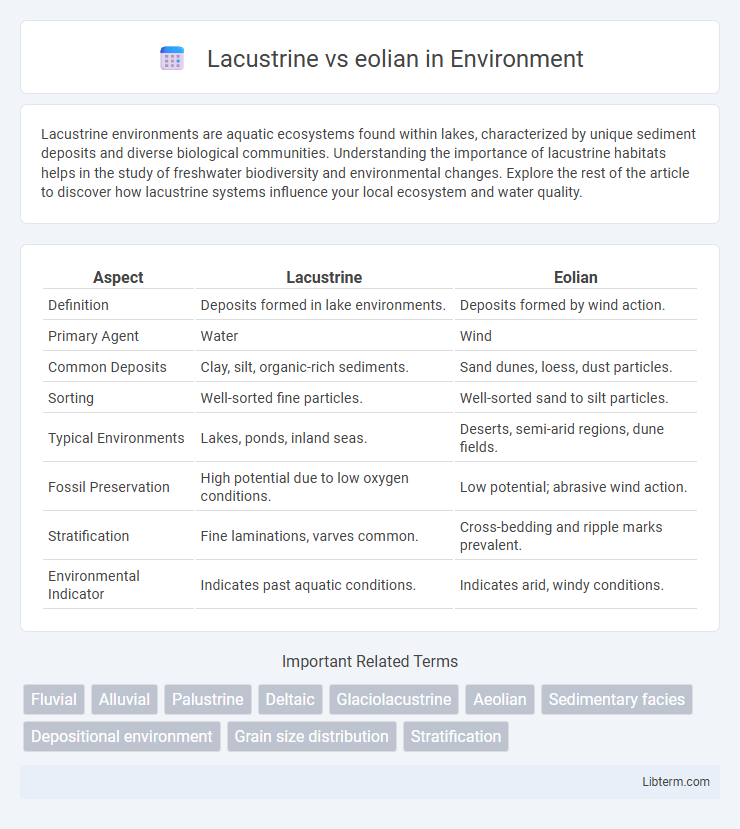Lacustrine environments are aquatic ecosystems found within lakes, characterized by unique sediment deposits and diverse biological communities. Understanding the importance of lacustrine habitats helps in the study of freshwater biodiversity and environmental changes. Explore the rest of the article to discover how lacustrine systems influence your local ecosystem and water quality.
Table of Comparison
| Aspect | Lacustrine | Eolian |
|---|---|---|
| Definition | Deposits formed in lake environments. | Deposits formed by wind action. |
| Primary Agent | Water | Wind |
| Common Deposits | Clay, silt, organic-rich sediments. | Sand dunes, loess, dust particles. |
| Sorting | Well-sorted fine particles. | Well-sorted sand to silt particles. |
| Typical Environments | Lakes, ponds, inland seas. | Deserts, semi-arid regions, dune fields. |
| Fossil Preservation | High potential due to low oxygen conditions. | Low potential; abrasive wind action. |
| Stratification | Fine laminations, varves common. | Cross-bedding and ripple marks prevalent. |
| Environmental Indicator | Indicates past aquatic conditions. | Indicates arid, windy conditions. |
Introduction to Lacustrine and Eolian Environments
Lacustrine environments are characterized by sedimentation in freshwater lake basins, often hosting fine-grained clays, silts, and organic-rich deposits that preserve diverse aquatic fossils and reflect fluctuating hydrological conditions. Eolian environments, shaped by wind-driven processes, primarily contain well-sorted, rounded sand grains forming dunes and loess deposits indicative of arid or semi-arid climates with sparse vegetation. Understanding the sedimentary structures and grain characteristics of lacustrine and eolian deposits helps reconstruct past climate variations and landscape evolution.
Defining Lacustrine Systems
Lacustrine systems are characterized by sedimentary deposits formed in lake environments, where fine-grained clays, silts, and organic-rich muds dominate due to low-energy water conditions. These systems contrast with eolian deposits, which result from wind-driven processes and typically consist of well-sorted sands and dust particles. Understanding lacustrine sedimentology is crucial for reconstructing past hydrological and climatic conditions in enclosed basin settings.
Characteristics of Eolian Processes
Eolian processes are characterized by the transportation and deposition of sediments through wind action, forming distinctive landforms such as dunes and loess deposits. These processes dominate in arid and semi-arid environments where vegetation is sparse, allowing fine particles like sand and silt to be easily mobilized. Eolian sediments are typically well-sorted and exhibit characteristics such as frosted grains and cross-bedding caused by wind direction changes.
Sedimentology: Lacustrine vs Eolian Deposits
Lacustrine deposits form in lake environments and typically consist of fine-grained sediments such as silts and clays, often showing well-sorted layers with organic-rich materials and evidence of seasonal laminations. Eolian deposits are characterized by wind-driven sediments like well-sorted, rounded sand grains with cross-bedding and ripple marks indicative of desert dunes or sandy plains. Sedimentological analysis differentiates these environments based on grain size distribution, sedimentary structures, and mineral composition, reflecting distinct depositional processes shaped by water versus wind dynamics.
Depositional Features and Landforms
Lacustrine depositional features are characterized by fine-grained sediments such as clays and silts, often forming well-bedded, laminated layers in lake basins with shorelines and deltas. Eolian deposits consist predominantly of well-sorted, fine to medium sand grains creating landforms like dunes, sand sheets, and loess plains shaped by wind action. The distinction between lacustrine and eolian landforms lies in sediment transport mechanisms, with water-driven processes forming horizontal stratified beds in lakes, contrasted by wind-driven ripple marks and cross-bedding in desert environments.
Paleoclimate Indicators in Both Environments
Lacustrine deposits preserve fine-grained sediments and organic matter that provide detailed records of past hydrological conditions, such as lake level fluctuations and climate-driven changes in precipitation. Eolian sediments, characterized by well-sorted sand grains and dune structures, capture variations in wind strength and aridity, reflecting shifts in regional aridity and atmospheric circulation patterns. By comparing lacustrine sediment proxies like pollen and isotopic composition with grain size and dune morphology in eolian environments, paleoclimatologists reconstruct comprehensive climate dynamics across terrestrial landscapes.
Fossil Records: Contrasts and Comparisons
Lacustrine fossil records typically reveal well-preserved organic material and diverse freshwater fauna due to sedimentation in calm lake environments, contrasting sharply with eolian deposits that often contain fragmented fossils and wind-abraded remains from arid, desert settings. Fossil assemblages in lacustrine strata frequently include fish, amphibians, and aquatic plants, while eolian records predominantly preserve hardy terrestrial organisms like insects and small reptiles adapted to dune ecosystems. These differences highlight the influence of depositional context on fossil preservation quality and biodiversity representation in paleontological studies.
Economic Significance of Lacustrine and Eolian Sediments
Lacustrine sediments, rich in organic matter and fine-grained minerals, are economically significant for hydrocarbon reservoirs and freshwater aquifers, often hosting valuable clays and evaporite minerals. Eolian sediments, predominantly composed of well-sorted sands, provide essential resources for the glass and construction industries and offer insights into past wind patterns useful for renewable energy site assessments. The contrasting depositional environments of lacustrine and eolian sediments influence their porosity, permeability, and mineral composition, directly impacting their economic utilization in natural resource extraction.
Case Studies: Notable Global Examples
Lacustrine environments, such as the Great Salt Lake in Utah and Lake Baikal in Russia, provide rich sedimentary records that reveal paleoenvironmental changes and climate variability. Eolian processes are exemplified by the Namib Desert in Namibia and the Sahara Desert, where wind-blown sand dunes and loess deposits illustrate aeolian sediment transport and deposition patterns. Comparative studies from these global case studies highlight the distinct sedimentary structures, grain sizes, and depositional dynamics that differentiate lacustrine from eolian systems.
Key Differences and Environmental Implications
Lacustrine environments are characterized by sediment deposition in freshwater lake basins, often resulting in fine-grained, organic-rich deposits that support diverse aquatic ecosystems and influence groundwater quality. Eolian processes involve wind-driven sediment transport and deposition, typically producing well-sorted sand dunes and loess deposits that shape arid landscapes and affect soil fertility and desertification patterns. Key differences include the medium of sediment transport--water in lacustrine settings versus air in eolian--and their distinct environmental impacts, such as lacustrine contributions to carbon sequestration and eolian roles in dust circulation and habitat formation.
Lacustrine Infographic

 libterm.com
libterm.com